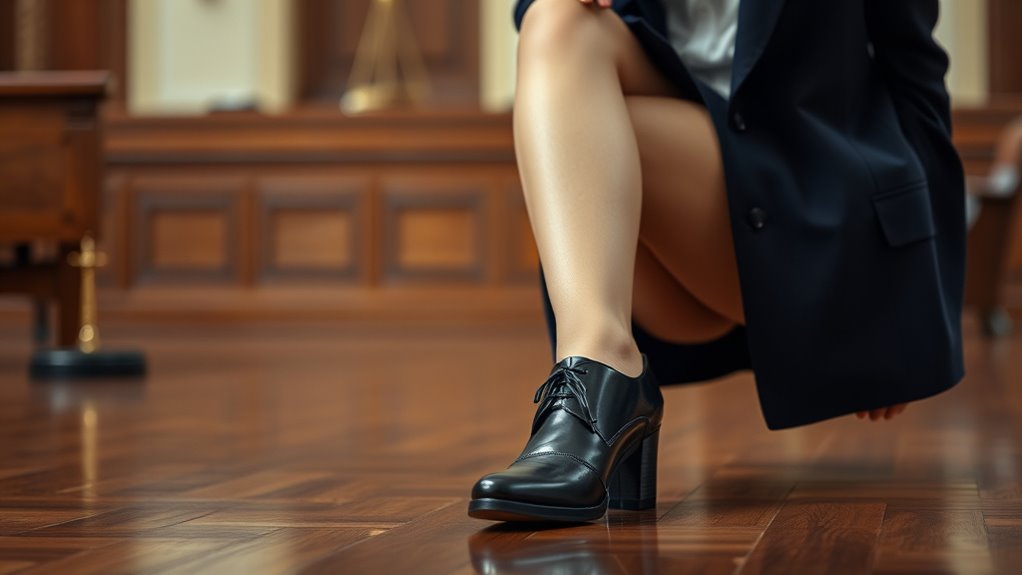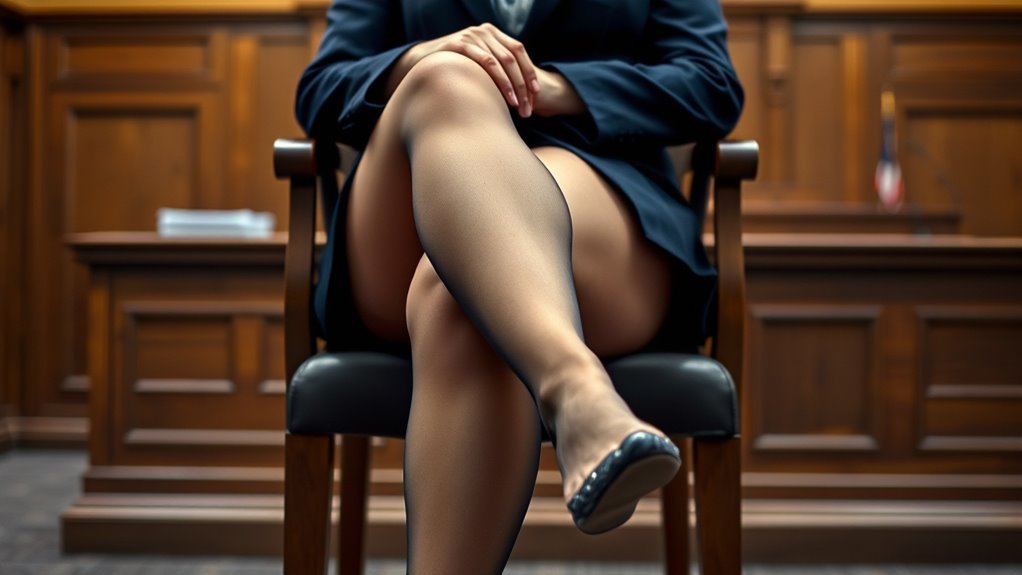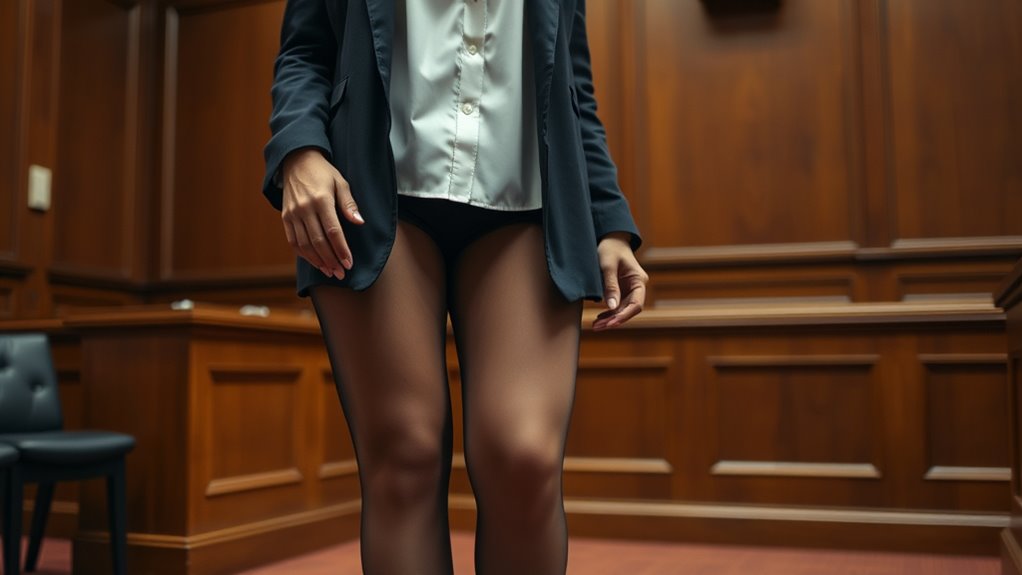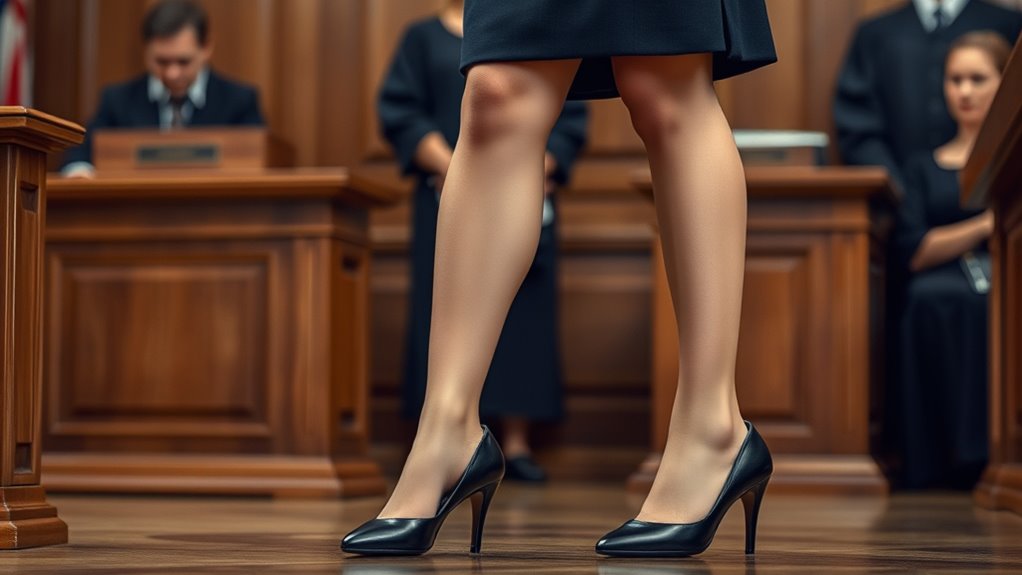Hosiery in courthouse dress codes reflects a balance between tradition, professionalism, and respect for individual rights. Courts historically emphasize decorum and authority, but enforcement can raise gender equality and religious accommodation issues. Policies should be clear and consistent, allowing for personal and religious expression while maintaining court decorum. To understand how courts navigate these complexities and ensure fair dress standards, explore the specific legal principles and case examples involved.
Key Takeaways
- Dress codes must balance professionalism and individual rights, including religious and personal expression, without discrimination.
- Courts can impose reasonable attire standards but should avoid gender-specific requirements like hosiery for women.
- Enforcement of dress codes should be consistent to prevent claims of bias or discrimination.
- Policies should accommodate religious beliefs and personal preferences while maintaining courtroom decorum.
- Legal precedents emphasize that dress code regulations must respect constitutional rights and avoid stereotypes.
Historical Context of Dress Codes in Judicial Settings

Dress codes in judicial settings have historically reflected societal expectations of professionalism, authority, and respect for the court. Over time, the dress code evolution shaped judicial attire standards to emphasize formality and decorum. Traditionally, judges and legal professionals wore dark robes, symbolizing neutrality and seriousness. These standards aimed to convey respect for the courtroom process and maintain public confidence. As societal norms shifted, some courts relaxed dress policies, but overall, judicial attire remained a symbol of authority. The emphasis on proper dress underscored the importance of presenting a polished, respectful appearance in court. This historical context highlights how dress codes in judicial settings serve to uphold the dignity and integrity of the judicial process, reinforcing the authority of those within the courtroom.
Legal Foundations and Relevant Court Cases

Legal standards and court rulings establish the boundaries for appropriate attire in judicial settings, ensuring that dress code enforcement aligns with constitutional principles and the court’s authority. Courts have repeatedly addressed issues related to judicial attire standards, emphasizing that dress codes must balance professionalism with individual rights. Notable cases, like *Heffron v. International Society for Krishna Consciousness*, highlight how dress code enforcement can be challenged if it appears discriminatory or inconsistent. These rulings reinforce that courts can set reasonable standards, but they cannot infringe on free expression or discriminate based on gender. The consideration of dress code enforcement is crucial to ensure policies are applied fairly and constitutionally. Ultimately, case law guides how dress code policies—including hosiery requirements—are implemented, ensuring they serve the court’s interest in decorum without overstepping constitutional protections.
Gender Equality and Discrimination Concerns

Gender equality remains a critical concern when it comes to courthouse dress codes, as enforcement can inadvertently reinforce stereotypes or result in discriminatory treatment. When dress code compliance is based on gendered expectations, it often perpetuates outdated gender stereotypes, making individuals feel judged or unfairly scrutinized. For example, requiring women to wear hosiery while allowing men to go bare-legged can suggest that women’s professionalism depends on appearance, not merit. Such policies risk marginalizing certain groups and creating an uneven standard for dress. To promote true gender equality, dress codes should focus on professionalism rather than gender-specific attire. Ensuring fair enforcement and avoiding stereotypical restrictions helps prevent discrimination and supports a more inclusive environment for all courthouse participants. Understanding decoding slang and informal language can also shed light on how dress codes and social expectations are communicated subtly or implicitly.
Religious Accommodations and Personal Expression

When considering courthouse attire, respecting religious beliefs and personal expression becomes just as important as maintaining professionalism. You should recognize that dress code flexibility allows individuals to express their faith through clothing choices, including hosiery. Courts often accommodate religious expression by permitting exceptions to standard dress codes, acknowledging that rigid rules can infringe on personal beliefs. This flexibility not only shows respect for diverse backgrounds but also upholds constitutional rights. You need to balance the need for a professional environment with the importance of individual religious practices. By allowing suitable adaptations, courts demonstrate an understanding that personal expression through attire, such as hosiery, is a crucial aspect of religious identity. This approach fosters inclusivity while maintaining the integrity of courthouse standards, especially considering the importance of dress code flexibility in accommodating diverse needs.
Implications for Policy Development and Enforcement

Developing and enforcing policies on hosiery in courthouse dress codes requires careful consideration to make certain they are clear, consistent, and respectful of individual rights. You need to establish guidelines that promote dress code compliance without unfairly targeting or restricting personal expression. Clear policies help prevent ambiguity and ensure everyone understands expectations, reducing enforcement issues. When enforcing these policies, you must balance maintaining professionalism with respecting religious or personal choices. Consistent application of rules is essential to avoid claims of discrimination or bias. Training staff on policy enforcement helps ensure fair treatment, while regular reviews allow updates aligned with legal standards. By focusing on clarity and fairness, you support effective policy development that upholds both order and individual rights within the courthouse. Additionally, understanding the environmental impacts of wood-burning can inform policies that promote more sustainable practices and reduce health risks associated with pollutants.
Frequently Asked Questions
How Do Courts Define Appropriate Hosiery for Judicial Attire?
You might wonder how courts define appropriate hosiery for judicial attire. Courts often look at historical attire and fashion influences to establish standards, emphasizing professionalism and decorum. They typically prefer neutral, conservative hosiery that complements traditional judicial clothing. By considering these factors, courts aim to maintain a respectful courtroom environment, ensuring that attire aligns with the formal tone expected in judicial settings while respecting evolving fashion trends.
Are There Specific Regulations Regarding Hosiery for Judges and Court Staff?
You should know that specific regulations regarding hosiery for judges and court staff vary by jurisdiction, but generally, they follow standards of appropriate judicial attire. Dress code enforcement often emphasizes professionalism and modesty, which may include hosiery requirements. While some courts specify hosiery colors or styles, others leave it to discretion. Staying informed about your court’s dress code guarantees you present yourself properly and adhere to the expected standards of judicial attire.
How Do Dress Code Policies Impact Court Appearances for Different Professions?
Ever wondered how dress code policies influence court appearances across different professions? These policies shape your professional image, balancing tradition and modern fashion trends. Gender considerations often dictate what’s acceptable, impacting your choice of attire. You adapt your wardrobe to meet these standards, ensuring respect and credibility. Ultimately, dress codes maintain courtroom decorum while allowing room for evolving fashion trends, but they also challenge you to navigate gender expectations thoughtfully.
What Are the Consequences for Violating Hosiery Dress Code Standards?
If you violate hosiery dress code standards, you could face several consequences. Dress code violations often lead to disciplinary actions like warnings, reprimands, or even being asked to leave the courtroom to correct your attire. These measures aim to uphold professionalism and decorum. Ignoring dress code policies can also impact your reputation and credibility, emphasizing the importance of adhering to established standards to avoid unnecessary disciplinary actions.
How Do Cultural Differences Influence Hosiery Requirements in Courts?
You might think courts are just about law, but cultural norms and fashion influences sneak in, shaping hosiery requirements. In some places, strict dress codes reflect local traditions, while others embrace modern fashion trends. These cultural differences influence what’s deemed appropriate, making hosiery rules a mirror of societal values. So, next time you dress for court, remember, your hosiery choices are more than fashion—they’re a statement of cultural identity.
Conclusion
As you consider dress codes in courthouses, remember how policies can impact fairness and individuality. For example, if a woman is barred from wearing hosiery due to outdated rules, it could be seen as discrimination. You must balance professionalism with personal expression, ensuring policies respect rights and diversity. By doing so, you foster a more equitable environment where all feel valued and respected in the pursuit of justice.








